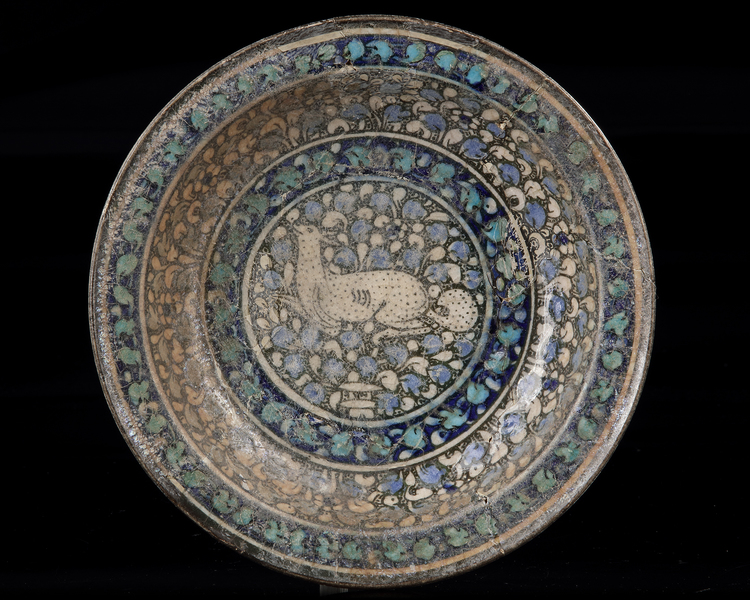* A SULTANABAD POTTERY DISH, NORTH PERSIA, LATE 13TH-EARLY 14TH CENTURY
The flat, perfectly turned, is hemispherical in shape and ends in a wide almost horizontal edge. It is supported by a ring foot. The lip is rounded. The decoration is complex but repetitive: on the outside, surrounded by black nets, is a large frieze of blue dots superimposed and separated by lines. On the inside, the motif consists of an animal lying on its legs, which the beautiful tail and the long ears probably characterised as a fox, its coat is speckled with black. The animal is found in an idyllic natural setting, entirely composed of a rich vegetation of branches, leaves and flowers painted in different shades of blue and organised in several friezes.
Diameter: 23.5 cm.
The dish belongs to the group called Sultanabad, whose name comes from a city in Iran (now Arak). Sultanabad ceramics were fashionable between the end of the 13th and 14th centuries AD, during the Mongol domination in Iran (reign of the Ilkhanids), but the center of production of these vessels remains a subject of open scientific discussion.
The technique used for the decoration is typical of the ceramics of the Mongolian period, it is the process known as decoration under colourless glaze. The motifs are painted in black, blue or grey on a white slip and then covered with a layer of transparent glaze, a slightly more elaborate variant provides for the use of a second greyish engobe (which covered the first layer of white), above which the black and white patterns are painted. These are therefore in slight relief and well perceptible to the touch.
PROVENANCE
Formerly Japanese collection, collected in the 1980-90s. Current ownership
art dealership, Switzerland acquired 2003. In Switzerland before 2005,
BIBLIOGRAPHY
J. SOUSTIEL, Islamic ceramics, Paris, 1985, pp. 198 ff., p. 216, nos. 239-241.
Terre d’Islam, The Middle Eastern ceramic collections of the Ariana Museum in Geneva, Geneva, 2014, pp.86 ff., nos. 73-78.
WATSON O., Ceramics from Islamic Lands, Kuwait National Museum, The al-Sabah Collection, London, 2004, pp. 373 ff., Q.7-Q9.
- SPECIAL NOTICE This lot is imported from outside the EU for sale using a temporary import regime. Import VAT is payable (at 9%) on the hammer price. The 30% buyers premium is subject to 21% VAT for EU citizens. When the buyer of this is registered an EU address but wishes to export the lot or complete the import into another EU country he must contact Oriental Art Auctions after the auction.




